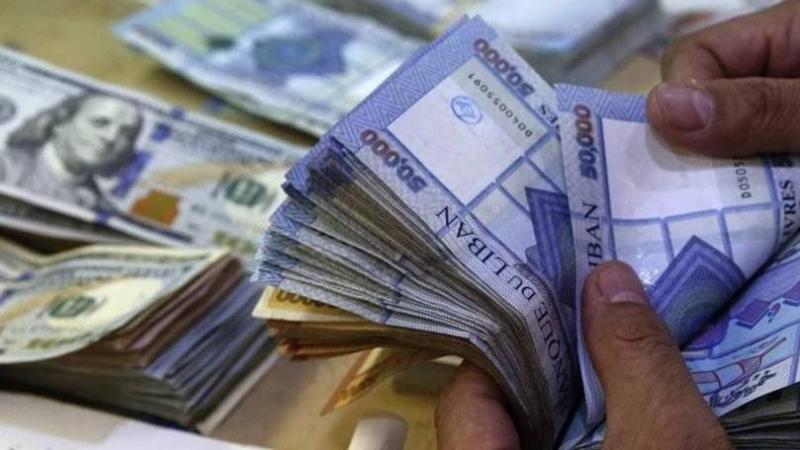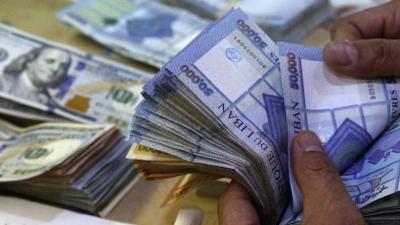The loss of value of the Lebanese national currency is not a new phenomenon in the Lebanese reality. The lira, which was a model of strength, stability, and resilience in the 1960s and 1970s, collapsed in the early 1980s, with its value against the dollar falling from 374 lira in 1983 to 2755 lira in 1993. This depreciation of approximately 735 times necessitated the printing of new denominations of currency with very large numbers that no one had imagined before, reaching up to 100,000 lira.
After a period of artificial calm during which the lira's exchange rate stabilized against the dollar at 1500 lira, the national currency began to lose value again at the end of 2019. The decline peaked on May 27, when the dollar reached 38,000 lira, and it has since stabilized at an average of 30,000 lira. This means that purchasing an item priced at 1000 dollars now requires carrying 300 bills of 100,000 lira each, compared to just 15 bills when the exchange rate was 1500 lira.
**Amendment of the "Currency and Credit" Law**
In light of this reality, which is likely to worsen, Zeiad Hawat, a member of the "Strong Republic" bloc, proposed an urgent draft law aiming to amend Articles 3 to 8 of the Currency and Credit Law, addressing the establishment of the central bank. The proposed amendments are related to the "features of the national currency," allowing for the issuance of banknotes in denominations of one lira, five liras, fifty liras, one hundred liras, two hundred and fifty liras, five hundred liras, one thousand lira, five thousand lira, ten thousand lira, and fifty thousand lira, and one hundred thousand lira. Consequently, the proposal calls for the permission to issue banknotes of denominations larger than 100,000 lira.
**Benefits of Increasing Zeros on the Currency**
The goal of the law is to provide practical solutions as transactions are now predominantly conducted in cash. Debit and credit cards are often rejected at many points of sale, and checks are generally unwelcome and often not accepted by banks for deposit. The vast majority of citizens convert dollars into lira, whether through Central Bank circulars (151, 158, 161) or at exchange offices, with no alternative currently available to dealing in lira. Hawat questions, "Which is better: to carry bundles of cash in bags to purchase the simplest necessities? Or to acknowledge reality and print banknotes of 500,000 or 1,000,000 lira, saving citizens the risks of theft, counting money... and many other impractical obstacles?!"
He states that "it is important to be realistic and not maintain proposals as if we are living on another planet. The problem of the lira's collapse and its loss of more than 95% of its value, or its depreciation by 20 times, has occurred. We need to start addressing the consequences of this, including creating larger denominations of currency to facilitate transactions among citizens. Hawat believes that "any rejection of this proposal on the grounds that it acknowledges inflation is purely populist, detached from reality, and serves no one." Inflation is a fact, and it is not possible to revert to a time when the lira was worth 1500."
**Risks of Accelerating Collapse**
Looking back to the period before the Lebanese Civil War and tracking the exchange rate of the lira against the dollar since the onset of the economic crisis supports Hawat's argument. According to a comparative study by Dr. Fadi Khalaf, author of "The Collapse of the Lira Between 1982 and 1992," the dollar increased by 46% in the first year of the crisis in 2019, while it rose by 295% in 2020, fluctuating between 200% and 250% in 2021. If this trend continues, the dollar's increase may exceed the percentages recorded during the war, potentially leading to a stage where 100,000 lira could equal 1,000 lira.
**Cautions Against Increasing Zeros on the Currency**
Conversely, accepting these increases signifies "a lack of hope for addressing the structural imbalance in the Lebanese economy," according to monetary economist Dr. Lyal Mansour. She notes that "the process of increasing zeros on the national currency has two direct implications: the first is a practical positive aspect, freeing citizens from the burden of carrying large amounts of cash and saving the state the cost of printing currency, as printing a 1,000 lira note today costs more than its actual value, while the general average should cost 10% of its value. The second is a negative psychological aspect, as issuing banknotes in larger denominations than currently available signifies a direct acknowledgment by the political and monetary authorities of two very serious matters: the inability to combat inflation and the long-term nature of the crisis, along with its negative repercussions, including the lira losing 95% of its purchasing power."
Printing large denomination notes represents, from Mansour's point of view, "a surrender to inflation and an acceptance of the undesirable reality. This is similar to an obese patient who loses the battle against their weight by simply agreeing to buy larger clothing sizes. This not only fails to help them lose weight but threatens to increase it further since they have adapted to the condition, making it seem normal." The same occurs with inflation, where the psychological impact of printing larger currency notes negatively affects the decline of the exchange rate. Although these notes do not influence the cash volume, their psychological effects translate into an increase in the exchange rate and consequently further collapse of the purchasing power of the Lebanese lira.
**Between Increasing and Decreasing Zeros**
While Lebanon is considering increasing zeros on its currency in response to inflation and the loss of the lira's purchasing power, several countries have taken the opposite approach by removing zeros from their currency. The significant difference between these two procedures in form parallels substantial similarities in essence. Both aim to eliminate the burden of carrying large amounts of paper and facilitate daily transactions with the national currency. However, the impact of removing zeros may be more positive from a morale standpoint, as "this typically occurs at the beginning of foundational stages or new initiatives and plans," according to Mansour.
**Reform is Essential**
Regrettably, these two formal measures have not aided collapsing economies. Venezuela, for instance, removed 14 zeros from its bolivar currency over 13 years in three phases, yet today's value of the bolivar remains negligible. Zimbabwe reached the point of printing a 100 trillion local dollar note, which was virtually worth 40 U.S. cents. In all cases, most countries that are forced to increase zeros ultimately find themselves compelled to remove them. Alongside experiences from Venezuela and Zimbabwe, similar occurrences have taken place over the past three decades in Algeria, Iran, Sudan, Bolivia, Romania, and Turkey, all of which resorted to removing zeros after increasing them.
Changing the sizes of paper currency may provide immediate relief and remove some obstacles to usage, but it does not substitute for reform. The value of the currency will naturally improve once trust is restored, and the state of law and institutions is reinstated, along with the establishment of flexible and reliable independent exchange rate systems, eliminating the need for changes in form. The question remains: In Lebanon, which will precede the experiences of Venezuela and Zimbabwe, or the need for reform?




